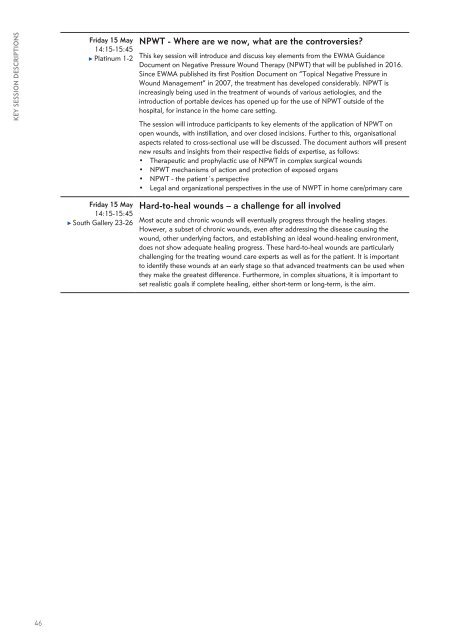You also want an ePaper? Increase the reach of your titles
YUMPU automatically turns print PDFs into web optimized ePapers that Google loves.
KEY SESSION DESCRIPTIONS<br />
Friday 15 May<br />
14:15-15:45<br />
Platinum 1-2<br />
NPWT - Where are we now, what are the controversies?<br />
This key session will introduce and discuss key elements from the EWMA Guidance<br />
Document on Negative Pressure Wound Therapy (NPWT) that will be published in 2016.<br />
Since EWMA published its first Position Document on “Topical Negative Pressure in<br />
Wound Management” in 2007, the treatment has developed considerably. NPWT is<br />
increasingly being used in the treatment of wounds of various aetiologies, and the<br />
introduction of portable devices has opened up for the use of NPWT outside of the<br />
hospital, for instance in the home care setting.<br />
The session will introduce <strong>part</strong>icipants to key elements of the application of NPWT on<br />
open wounds, with instillation, and over closed incisions. Further to this, organisational<br />
aspects related to cross-sectional use will be discussed. The document authors will present<br />
new results and insights from their respective fields of expertise, as follows:<br />
• Therapeutic and prophylactic use of NPWT in complex surgical wounds<br />
• NPWT mechanisms of action and protection of exposed organs<br />
• NPWT - the patient´s perspective<br />
• Legal and organizational perspectives in the use of NWPT in home care/primary care<br />
Friday 15 May<br />
14:15-15:45<br />
South Gallery 23-26<br />
Hard-to-heal wounds – a challenge for all involved<br />
Most acute and chronic wounds will eventually progress through the healing stages.<br />
However, a subset of chronic wounds, even after addressing the disease causing the<br />
wound, other underlying factors, and establishing an ideal wound-healing environment,<br />
does not show adequate healing progress. These hard-to-heal wounds are <strong>part</strong>icularly<br />
challenging for the treating wound care experts as well as for the patient. It is important<br />
to identify these wounds at an early stage so that advanced treatments can be used when<br />
they make the greatest difference. Furthermore, in complex situations, it is important to<br />
set realistic goals if complete healing, either short-term or long-term, is the aim.<br />
46


